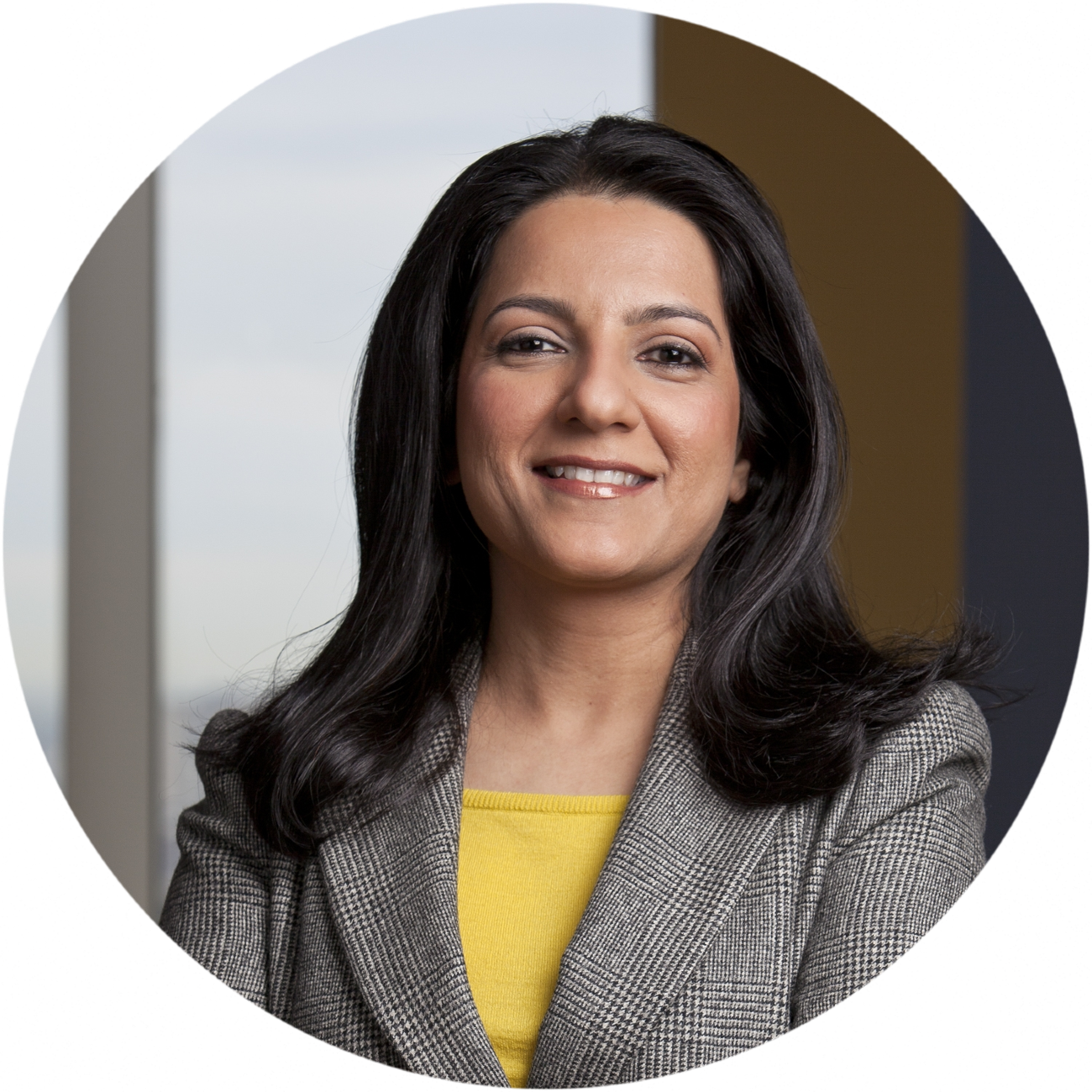MARKETS NEED DIVERSITY JUST AS DEMOCRACIES NEED PLURAILITY
Rupal Bhansali, CIO of Global Equities, Ariel Investments

Rupal Bhansali
CIO of Global Equities, Ariel Investments
Unlike most kids who grow up on fairy tales, I was raised on stock stories. My dad owned a stock-broking business in India and I often overheard him talking to clients. My early exposure to stocks was fascinating and harrowing because our family fortunes fluctuated with the vagaries of the stock market. If markets fell, money was tight and I was late paying tuition fees at school. Thus, at the age of nine, I experienced first-hand the adage “Bills don’t come due at market tops”.
Money – or not having it – posed such a day-to-day challenge during my childhood, that I was determined to understand it, earn it and invest it in the right way. So, I studied accounting in school and took on internships in finance during college. While I was very determined, I did not have a mentor or a master plan. I just kept walking in the direction of my destination till I got there.
Fast forward to today – I manage multi-billion dollar global equity portfolios on behalf of sophisticated institutional clients. I am also among the 1.3% of sole female portfolio managers to manage a mutual fund in the US[1]. I am neither white nor male but have risen through the ranks to become the Chief Investment Officer of Global Equities at Ariel Investments – living proof that the glass ceiling can be broken.
I am often asked: What does it feel like to have achieved such rare success on Wall Street – as a woman and woman of color? My answer is simple: lonely. I am disappointed to see such a staggeringly low number of women in finance and in the C-suite. I am a firm believer, if I can do it, anybody can do it. This is why I candidly shared the ups and downs of my personal and professional success in my book, “Non-Consensus Investing – Being Right When Everyone Else is Wrong” so that others can accomplish what I did[2].
They say there is nothing worse than being poor. I disagree. The worst thing is being poor after you have been well off. My early life was a roller coaster on the money train, with as many wrecks as riches. This experience taught me a valuable lesson and has become the signature element of my investment approach: not losing money (risk management) is as important as making it (return management).
My biggest concern is that what I experienced in my early life – being well off and then poor – many adults may experience in their later life, as they don’t set aside enough money to retire comfortably. Moreover, some people invest based on past high returns and count on them to persist. In my view, this is a risky assumption as “past performance does not guarantee future results”. Last but not least, some people tend to ignore the risk profile of their investments and singularly focus on returns. This is the trap investors fell for, in owning banks prior to the Great Financial Crisis when they were generating high returns on equity, only to discover much later, the outsized risks being taken to generate those returns. This belated attention to risk proved too late as bank stocks had already crashed. In investing, ignorance is not bliss, but loss, which explains why it is crucial to consider the rewards and the risks.
A looming risk I see in markets is the danger of self-fulfilling prophecies masquerading as investment success, where stock prices are driven less by fundamentals and more by flows. In my view, there is a mammoth battle being played out between formulaic investors (passive and quantitative) versus fundamental investors (stock pickers).
Of late, it has become an article of faith for people to invest passively. A virtually uninterrupted streak of high and positive returns for a decade, alongside low costs, has made it a “no-brainer” decision. But this is not necessarily sound investing. As mentioned before, I believe that was the kind of misguided thinking that prevailed with bank stocks pre-2008. So let’s consider some of the risks.
In my view, most investors fixate on the low entry costs of Passive but few pause to consider the potentially high exit costs. Recall that Passive has not been stress tested with outflows, as the last decade has predominantly seen inflows. If index funds witnessed net redemptions, Active investors would have to step up and buy but they may pay far lower prices than those paid by Passive investors (as the former pay attention to fundamentals and valuations while the latter disregards them). The larger the difference between the fair price of a security based on fundamentals versus that set by flows the larger the potential exit cost for the Passive investor. Let’s say the Active investor judges the fair price to be 20% lower – this is 200x the entry cost of say the 0.1% management fee levied by an index fund. This is how Passive can prove to be the proverbial “Penny Wise Pound Foolish” trade. In the late 1990s, the QQQ ETFs were a cheap and popular way to own the NASDAQ index. Unfortunately, the index and its associated ETF fell over 75% between 2000 and 2002 – in my opinion, this shows that the cost to exit an exposure can be multiples higher than the cost to engage. This is one possible risk – I believe there are many others, for instance, liquidity risk.
Two institutions – Vanguard and Blackrock – account for the majority of funds managed passively. I believe any large sales made by them to meet redemptions would overwhelm the average daily value traded in markets, as these vehicles were designed to be “buy and hold”, not actively trade in markets. I believe a rush for the exits by their investors would leave them with no choice but to sell. If they can’t find enough liquidity, prices could gap down or circuit breakers could kick in and prevent them from meeting redemption requests. Investors count on these investments to be liquid not illiquid – that assumption could be tested in a market rout. Also, investors may believe that the market’s appreciation is due to profit growth or central bank easing. But let’s consider the counterfactual – could it also have been caused by the sheer weight of persistent inflows? If that were the case, on the way out, I believe large outflows could cause this edifice to become a house of cards – collapsing under its own heavyweight.
Hopefully, these risks highlight my belief that Passive is not a panacea. Just like Active management, Passive comes with its own set of risks and rewards that must be carefully weighed. Simply because these risks have not materialized, does not mean they don’t exist.
I now want to flip the debate to the rewards of Active, which many view as non-existent due to their higher cost (fees) and risk (of underperformance). The headline performance record appears to validate the inferiority of Active managers and facts don’t lie – or do they?
Two papers[3] published in the Journal of Financial Economics and Financial Analysts Journal in 2016 and 2017 respectively concluded that funds with a high Active Share as well as low portfolio turnover (holding durations of more than two years) have outperformed, before fees, on average by over 2% per annum. How is this possible? The devil is in the detail. According to the papers, it was the closet indexers or those with a low Active Share, who underperformed and diluted the record of all Active managers.
Frankly, such faux Active managers should never have been allowed to label themselves “Active”. I believe this lack of truth in labeling has perpetuated the urban myth that Active has underperformed when in reality, it has not. Sadly, in a world where attention spans are low and snappy sound-bites loom large, it is easy to fall for the headlines and not dig deeper. As fiduciaries, we owe it to the profession to research the full truth and not settle for half-truths.
I am not against Passive per se – it provides a choice and is a source of competition to Active. However, it is increasingly being perceived and pitched as the default or no-brainer choice, which is a short distance away from becoming the only choice. Without countervailing forces, markets can become pawns of flows rather than fundamentals. Just as democracies need plurality to prosper, markets need diversity (of views and participants) to flourish.
You can hear more from Rupal at the Women in Asset Management Virtual Summit on September 9th 2020. Register for your free place here.
[1] Source: Morningstar Study, November 2016
[2] Here is some career advice for young women from my book: excerpted chapter.
[3] Source: Martijn Cremers, “Active Share and the Three Pillars of Active Management: Skill, Conviction and Opportunity,” Financial Analysts Journal 73, no. 2 (2017): 61–79; Martijn Cremers and Ankur Pareek, “Patient Capital Outperformance: The Investment Skill of High Active Share Managers Who Trade Infrequently,” Journal of Financial Economics 122 (2016): 288–306;

